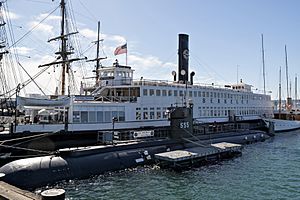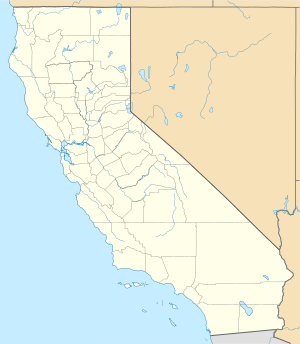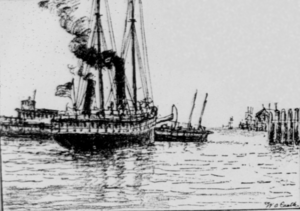Berkeley (ferryboat) facts for kids

Berkeley ferryboat and USS Dolphin at San Diego Maritime Museum
|
|
| History | |
|---|---|
| Name | Berkeley |
| Owner | Southern Pacific Railroad |
| Builder | Union Iron Works |
| Launched | 18 October 1898 |
| In service | 1898 |
| Out of service | 1958 |
| Status | Museum ship |
| General characteristics | |
| Tonnage | 1883 |
| Length | 279 ft (85 m) |
| Beam | 64 ft (20 m) |
| Draft | 9 ft (2.7 m) |
| Installed power | triple-expansion steam engine 1,450 hp (1,080 kW) |
|
Berkeley
|
|
| Location | San Diego, California |
| Built | 1898 |
| Architect | Union Iron Works |
| NRHP reference No. | 90002220 |
| Significant dates | |
| Added to NRHP | December 14, 1990 |
| Designated NHL | December 14, 1990 |
The SS Berkeley is a famous old ferryboat. For sixty years, she carried people across San Francisco Bay. She traveled between the Oakland Pier and the San Francisco Ferry Building.
The Berkeley was built in 1898 by the Union Iron Works in San Francisco. She was very important after the 1906 San Francisco earthquake. She helped ferry many people safely across the bay to Oakland.
| Top - 0-9 A B C D E F G H I J K L M N O P Q R S T U V W X Y Z |
Berkeley Joins the Fleet
The Berkeley started regular service in 1898. She was the first ferry on the West Coast to use a propeller. When she launched on October 18, 1898, she was the biggest commuter ferry in the United States. She could carry 1,700 passengers! She was also one of the first ferries to use a triple-expansion steam engine. This was a very powerful engine for its time.
A Close Call: The 1900 Collision
On October 3, 1900, the Berkeley had a collision. She was leaving her dock in San Francisco. She crashed into a larger ship called the SS Columbia.
The captains misunderstood each other's signals. Captain Blaker of the Berkeley thought his ship could pass in front of the Columbia. But it was too late when they realized the Berkeley could not get past the huge Columbia. Both ships tried to stop, but they still hit each other.
One lifeboat on the Berkeley was destroyed. The Columbia's front was badly damaged. Another ferry, the Newark, took over for the Berkeley while she was fixed. The Berkeley was not as badly damaged as the Columbia.
End of Service and New Life
In the spring of 1958, the Berkeley was taken out of service for repairs. But she never went back to work. The Southern Pacific Railroad decided to stop all ferry services on July 29, 1958.
The Berkeley was then put up for sale. A company wanted to use her to process whales. But before that happened, she was sold again. A man named Bill Conover, who loved ferryboats, bought her.
From Ferry to Gift Shop
Conover had the Berkeley docked in Sausalito. This is a small town on the bay. He turned her into a gift shop called "Trade Fair."
However, the Berkeley was not taken care of very well as a gift shop. After 12 years, she was in bad shape.
A Museum Ship
In 1973, the Maritime Museum of San Diego bought her. On May 31, 1973, tugboats pulled her out of San Francisco Bay. Three days later, she arrived in San Diego. There, she was fixed up and restored.
Today, the Berkeley is the main "building" of the Maritime Museum of San Diego. You can visit her and explore inside!
Interesting Facts About Berkeley
- In 1990, the Berkeley was named a National Historic Landmark. This means she is a very important historical place.
- In 2000, she also became a California Historical Landmark (No. 1031).
- While the Berkeley was docked in Sausalito, a famous actor named Sterling Hayden rented a part of her. He used one of her pilot houses as an office. There, he wrote his autobiography, Wanderer.
- When the Berkeley was being built in 1898, a battleship was being built next to her. This was the USS Wisconsin (BB-9).
- On April 15, 1899, the Berkeley might have carried the Stanford Axe. This was after students from the University of California stole it from Stanford after a baseball game.
Current Condition
The big boilers that made the steam for the engine no longer work. One of them is cut open so visitors can see inside.
Below the main deck, much of the original machinery still works. Instead of steam, compressed air is used to power the machines. This lets visitors see them in action safely.
The back part of the Berkeley has two workshops. Woodworking is done on the main deck. A room for mixing and storing paint is below it.
See also
 In Spanish: Berkeley (ferry) para niños
In Spanish: Berkeley (ferry) para niños



